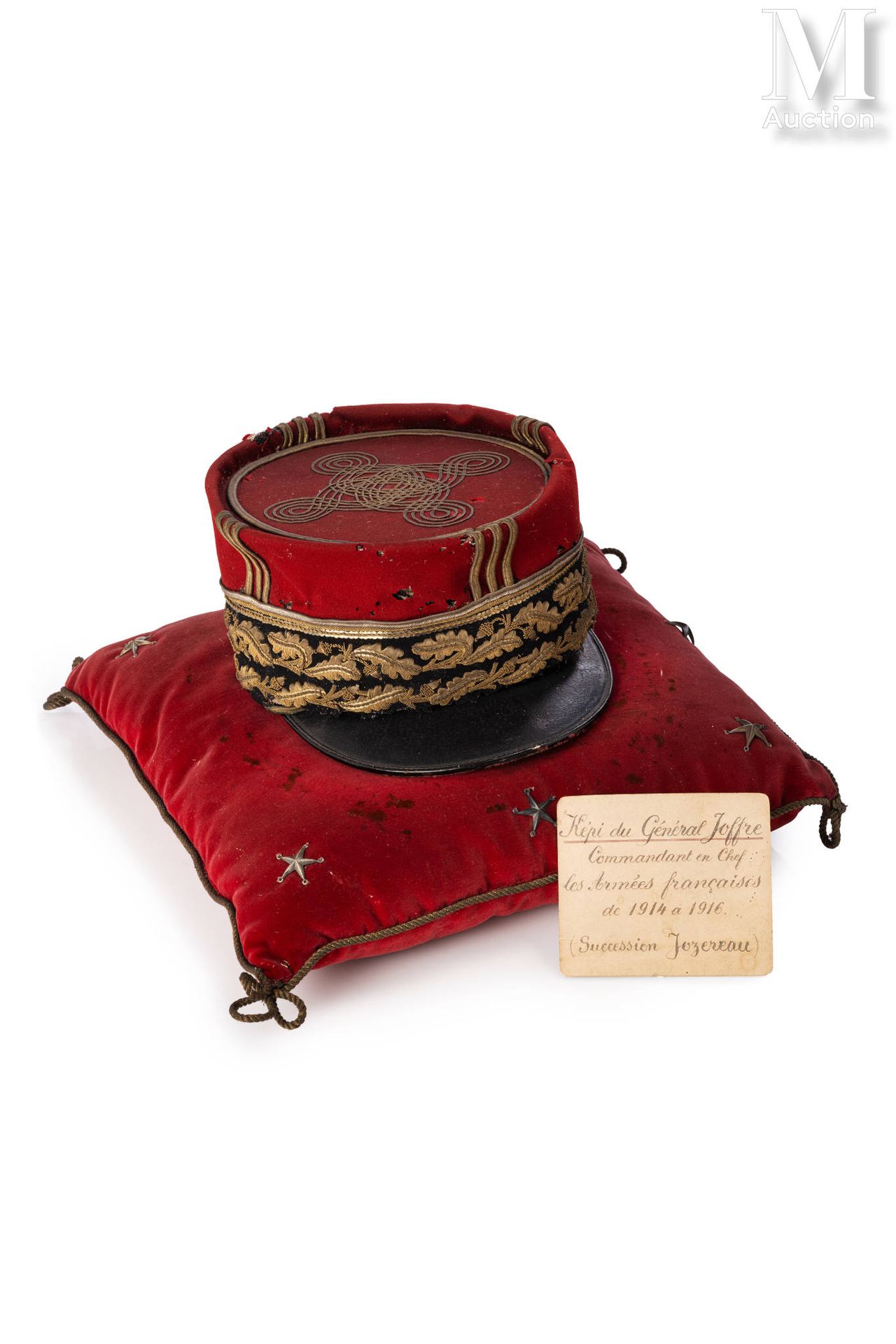Description
RARE KÉPI DU GÉNÉRAL JOFFRE PORTÉ LORS DE LA BATAILLE DE LA MARNE EN 1914
Kepi in madder-colored cloth with gold braid and soutache, headband in black cloth entirely embroidered with two oak leaf courses and edged at the top with a double cordonnet of gold thread and a baguette in gold sequins and cannetilles. Black waxed and varnished leather visor, lined with black embossed morocco, and trimmed with a black lacquered calfskin ruffle folded astride the outer edge. Unmarked black silk inner headpiece. Poor condition (holes and accidents, in need of restoration). First World War era. Total height with visor 11 cm, height of black headband 5.5 cm, height of madder headband 4.5 cm. Presented on a red velvet cushion adorned with seven silver-plated marshal's stars (stains). L. 33 cm. The attribution of this kepi is confirmed by a number of documents, including handwritten letters from Dr. Sichère and Paul Dubure, sales slips, period postcards showing the kepi worn by General Joffre, etc. It was worn by General Joffre from the start of the First World War until his elevation to the title of Marshal of France, when he donated it to Mr. and Mrs. Jozereau. Provenance - General Joseph Joffre (1852-1931), used in 1914, 1915 and 1916. - Given in 1917 by his wife to M. and Mme Gaston Jozereau as a token of friendship. - Sale to the estate of M. Jozereau, Maître Godeau, December 6, 1950, lot 63 (sold for 600 frs). - Collection Paul Dubure, military antiquarian in Paris. - Thierry de Maigret sale, Drouot, October 12, 2006, lot 47 (sold for €2,430). - Private collection, Paris. History Joseph Joffre, from a modest family in Rivesaltes, Pyrénées-Orientales, entered the École Polytechnique in 1869. His studies were interrupted by the war, and he first saw action at the siege of Paris in 1870. As an officer in the engineering corps, he helped to defend the capital in 1874, then the Pontarlier region in 1879. After the Franco-Prussian War came the period of colonial conquest. Joffre was to take part in this period, and for 15 years served with distinction in a wide variety of countries. Put at Admiral Courbet's disposal in 1885 during the war against China, he led the siege of Ba-Dinh, commanded the engineers in Formosa, then Hanoi, where he organized the defense of Upper Tonkin. In Sudan, in 1892, he supervised work on the railway from Kayes to Niger. Coming to the aid of the Bonnier column, massacred near Timbuktu in 1894, he seized the town, restored order and organized French rule. In Madagascar, he established the defenses of Diégo-Suarez and was appointed Brigadier General in 1901. Joffre's colonial career was over. Returning to France, he took on a number of high-level commands, becoming head of the French Army within 10 years. Director of Engineering, Commander of an Infantry Division, then of an Army Corps, he was a member of the Conseil Supérieur de la Guerre in 1910 and Chief of the General Staff of the Army in 1911. On August 2, 1914, Germany declared war on France, and General Joffre took charge of operations as Commander-in-Chief of the Northern and North-Eastern Armies. The invasion of Belgium forced him to modify his plan and shift his main effort northwards, but the French armies were forced to withdraw in the face of vastly superior forces. Joffre, gifted with uncommon self-control and strength of character, ordered the retreat and conceived the ingenious maneuver of resuming the offensive. This maneuver was admirably executed by both leaders and troops, and led to the famous victory of the Marne. The title of "victor of the Marne" adorned Joffre's name with immortal glory. From then on, the character of war changed, with continuous lines of trenches separating opposing armies. Joffre waged an active war of attrition. These were the offensives of Artois and Champagne in 1914 and 1915. During the Battle of Verdun, which absorbed all the French Army's vital forces, he gave his second-in-command, General Pétain, the means of victory, and launched the Somme offensive in July 1916, which relieved the citadel front. On December 26, 1916, Joffre receives the baton of Marshal of France. Marshal Joffre hands over command-in-chief to General Nivelle. After the war, he undertook diplomatic missions in America and Japan, and was elected to the Académie Française. He died in 1931 and is buried at his estate in Louveciennes, near Paris. Few army chiefs in our history have held France's destiny in their hands. Joffre was one of them, and one of the greatest. In the tragic hours of August and September 1914, he saved his country. (text repri
395
RARE KÉPI DU GÉNÉRAL JOFFRE PORTÉ LORS DE LA BATAILLE DE LA MARNE EN 1914
